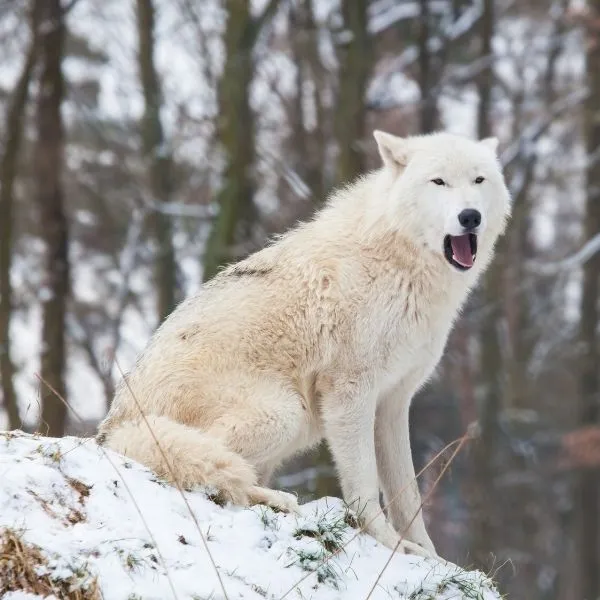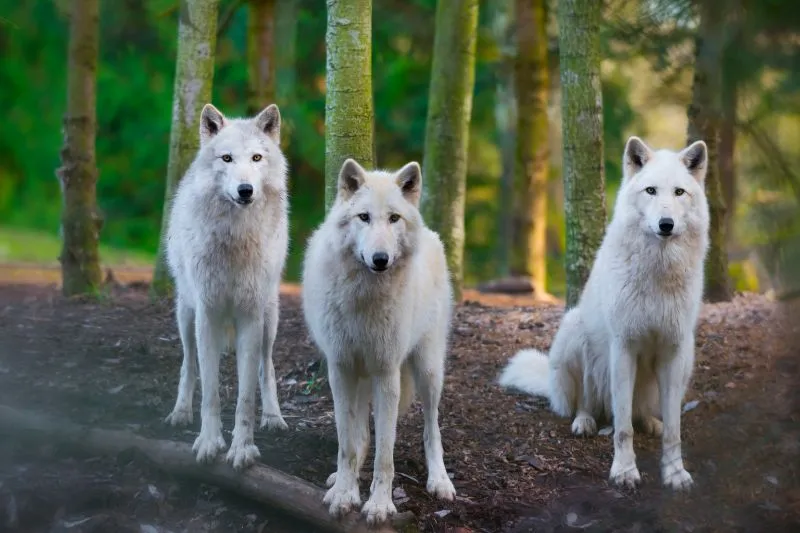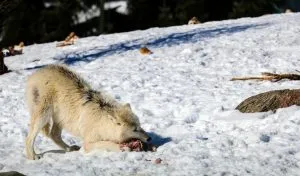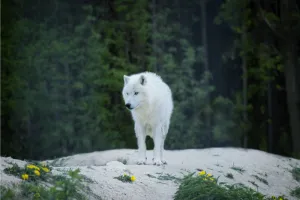Arctic wolves (Canis lupus arctos) are formidable predators found in the High Arctic regions. Famous for their white fur and resilience to sub-zero conditions, the Arctic wolves are the elusive descendants of the North American Gray Wolf.
Yet, living in the vast and isolated plains of the Arctic tundra, many aspects of the Arctic wolves’ lives remain shrouded in mystery. So, we have gathered 19 facts to get to know this mysterious animal that bit better!
- 1. Arctic wolves live in the high arctic regions of Canada and Greenland
- 2. Arctic wolves originate from the North American Gray Wolf
- 3. There are three distinct populations of arctic wolves.
- 4. Just 0.6% of Arctic wolf encounters are aggressive
- 5. Arctic wolves are hypercarnivores
- 6. Arctic wolves can eat up to 20 pounds of meat in one sitting
- 7. Arctic wolves are highly intelligent and social.
- 8. Arctic wolves are keystone species in the Arctic
- 9. Arctic wolves have no natural predators
- 10. Arctic wolves are the only wolves with white fur
- 11. Arctic wolves have short extremities
- 12. Arctic wolves have increased blood flow to their paws
- 13. Arctic wolves have very large territories
- 14. Arctic wolves have used the same den for over 750 years!
- 15. Arctic wolf pups rarely leave the den
- 16. The Arctic wolf has been cloned!
- 17. Arctic wolves are not currently endangered
- 18. Urbanization is harmful to Arctic wolves
- 19. Arctic wolves are threatened by climate change
1. Arctic wolves live in the high arctic regions of Canada and Greenland
They can be found specifically in the Canadian Arctic Archipelago on Victoria Island, Banks Island, Baffin Island, and Ellesmere Island.
To learn more about the habitat and homes, see our article on where Arctic wolves live.
2. Arctic wolves originate from the North American Gray Wolf
The scientific name of the arctic wolf is Canis lupus arctos. Breaking this down we get ‘Canis lupus’ from the gray wolf and ‘arctos’ meaning arctic.
It said that, relatively recently, the North American gray wolf migrated north and colonized regions of the arctic tundra. Over time, they developed adaptations to the cold climate and became distinct populations of the arctic wolves that we know and love today
3. There are three distinct populations of arctic wolves.
Recent genetic research investigating the differences between subspecies of gray wolves has made some interesting findings; Three distinct populations of arctic wolves have been named; ‘west arctic’, ‘east arctic’, and ‘polar’.
Arctic wolves found on Victoria and Banks Island are called ‘west arctic wolves’, whilst those found on Baffin Island are named ‘east arctic wolves’. Lastly, wolves found on Ellesmere Island and Greenland are named ‘polar wolves’.
Each subspecies has adapted unique behaviours to help them survive in their respective habitats.
The polar wolves are the most genetically different from the gray wolf and other Arctic wolves. This is due to their increased period of isolation from the grey wolf, reducing the chance of outbreeding and increasing inbreeding1 (source: M.H.S. Sinding et al,PLOS Genetics, Vol. 14, No. 11, 2018).
4. Just 0.6% of Arctic wolf encounters are aggressive
The arctic wolf tends to be less aggressive than their close relative, the North American Gray wolf. This is thought to be due to less frequent contact with humans, resulting in a lack of fear with only 0.6% of encounters classified as aggressive! 2(source: View of Behaviors of High Arctic Wolves in Response to Humans (ucalgary.ca)
Yet, as humans, we are predisposed to interpret wild animal behavior as aggressive more than anything. Curiosity or playfulness can be mistakenly viewed as threatening behavior. This has historically resulted in artic wolves being shot down by eco-tourists, scientists, and locals alike. Such was the case in Northern Greenland when a group of tourists was closely approached by an Arctic wolf. 3(source: View of Behaviors of High Arctic Wolves in Response to Humans (ucalgary.ca)
To learn more about the curious behavior of the Arctic wolf check out our previous article here! Are Arctic Wolves Dangerous? Can They Be Tamed? – Polar Guidebook
5. Arctic wolves are hypercarnivores
Over 70% of the artic wolf’s diet consists of meat found in the Arctic; making them hypercarnivores. The Arctic wolf has the trademark large brain, high intelligence, and hunting instincts of a carnivore. Their teeth and digestive system are also highly adapted to attack, kill, crunch, and digest all the parts of an animal, including bones. Such traits make the Arctic wolves a formidable apex predator of the Arctic food web.
Suited to this diet, the arctic wolf actively hunts populations of caribou, muskoxen, arctic hares, lemmings, and invertebrates 4(source: Exploring the diet of arctic wolves (Canis lupus arctos) at their northern range limit (gla.ac.uk). They will also eat plant matter such as berries in the summer months, but only as a last resort.
Sometimes the wolves will even eat fish, although they tend to stick to inland areas and away from risky polar bear territory!
The Arctic wolf can also be opportunistic at times. They will scavenge upon the carcasses left by polar bears and other predators if live prey is scarce.
See our full article if you want to learn more about the diet of the Arctic Wolf.
6. Arctic wolves can eat up to 20 pounds of meat in one sitting
The Arctic wolves can consume up to 20 pounds of meat and then may go days without eating anything. The Arctic tundra d is incredibly isolated and vast, therefore the wolves are unsure of when their next meal will come. It could be days before they encounter more prey and so each meal needs to be eaten like it could be their last! 5(source: Wolf Biology and Behavior | International Wolf Center)
Between larger prey such as caribou, wolves may snack on smaller rodents such as lemmings, invertebrates, and berries for sustenance. They make use of whatever they can get their paws on!

7. Arctic wolves are highly intelligent and social.
The Arctic wolf is rarely found alone because their strength lies in numbers. And, in the vast arctic tundra, maintaining effective communication within a wolf pack is key to survival.
Howling is one vital behavior that lets the rest of the pack know a wolf’s location. In times of distress when an arctic wolf is caught alone by a rival wolf pack or predator, howling is essential to alert the rest of the pack.
Teamwork is also vital among a pack to take down larger prey such as muskox. Muskox can feed a whole pack of wolves and the opportunity to feed must not be squandered. Therefore, the wolves display high levels of coordination.
When the large prey animals run out into the open, a pack of wolves will select one animal to pursue. Often the oldest or sickest prey will be selected. The wolf pack then works as a team to flank the animal and run it down. Sometimes the wolves may maintain this chase over several miles.
8. Arctic wolves are keystone species in the Arctic
Keystone species act as indicators of the overall health of an ecosystem.
In the terrestrial arctic ecosystems, wolves are the apex predator. Therefore, if arctic wolf populations are in healthy numbers, this reflects stable populations of herbivorous prey such as caribou and muskoxen. In turn, this reflects a diverse, and abundant presence of plant communities for herbivores to utilize.
Thus, arctic wolves reflect the maintenance of biodiversity in the Arctic.
9. Arctic wolves have no natural predators
Due to the vast, isolated, and harsh Arctic conditions, there are no natural predators of the Arctic wolf. And if there are any predatory encounters, these occur due to specific and particular circumstances.
In particularly harsh winters when food is sparse, polar bears or rival wolf packs may engage in desperate competition or predatory conflict with Arctic wolves. Arctic wolf pups are often most at risk of predation as they are very vulnerable.
Ashamedly, it is humans that pose the biggest threat to the Arctic wolves. With the onset of human-induced global warming, arctic wolf territories are at serious risk of decline. This may result in less food available to sustain arctic wolf populations and a higher frequency of conflict with rival wolf packs. Additionally, the melting of sea ice that results from human activities pushes polar bears further inland toward arctic wolf territories. This also increases the competition for food and the likelihood of fatal encounters.
To find out more about the predators of the Arctic Wolves check out our previous article! What are the Predators of Arctic Wolves?
10. Arctic wolves are the only wolves with white fur
The Arctic wolves are infamous for their unique white fur that contrasts with the grey fur of their North American relatives.
White fur allows the arctic wolves to camouflage into their snowy habitat. This is useful to hide from rival wolf packs, and human hunters and for successful ambushes of prey.
However, black arctic wolves have been observed in the high arctic regions! Researchers believe this is likely due to a random genetic mutation that produces melanin. Melanin is a natural dark brown pigment that results in the display of black fur rather than white.

11. Arctic wolves have short extremities
The arctic wolf has shorter muzzles, legs, and ears than other closely related species of wolves.
This allows their extremities to remain closer to their warm chest and stomach so that the damaging effects of frostbite are not felt by this mighty, cold-adapted wolf 6(source: Arctic Wolf: The High Arctic – Laura DeLallo – Google Books)
12. Arctic wolves have increased blood flow to their paws
When walking along the cold, icy terrain in the Arctic, arctic wolves can increase blood flow to their paws (vasodilation). This allows the tissues in their feet to stay above freezing level and prevents damage. 7(Source: Arctic wolves have unique adaptation to protect their paws (wolf.org)
Humans wish to have such a novel mechanism! Instead, when humans enter a cold environment, vasoconstriction occurs whereby blood flow to the fingers and toes is restricted. This conserves body heat but causes extremities to become numb and oblivious to frostbite in particularly harsh conditions. Mankind would not fare as well as the Arctic wolf in sub-zero conditions!
13. Arctic wolves have very large territories
Arctic wolf territories are much larger than gray wolf territories.
For many km at a time, the arctic tundra is void of many food resources. Therefore, wolf packs will tend to claim larger territories that should harbor a sufficient amount of food for survival. Such territories can surpass 1,000 km2. 8(source: How do wolves choose the size of their territory? (wolf.org)
Large territories are maintained through careful urination and scent marking. The pheromones released from wolf urine can be detected by rival packs and this prevents unwelcome visitors from entering the area.
However, this is not foolproof. Sometimes starvation and desperation can drive wolves into rival territories where conflicts may arise.
14. Arctic wolves have used the same den for over 750 years!
Amazingly, a den found on Ellesmere Island has been used by Arctic wolves for the past 783 years!
Scientists were able to approximate how long the den has been used by radiocarbon dating the bones found around the den. 9(source: Wolves thrive in some of the harshest places on Earth | Nature of Things (cbc.ca)
Due to the harsh wind, rain, and snow in the Arctic, wolves use permanent, strong structures such as boulders and rock caves to keep their dens stable and habitable for many many years. 10(source: 145possibleuseofwolfden.pdf)
Additionally, the digging of new dens year in and year out would use up a lot of the wolves’ vital energy that is needed to survive the harsh climate. Therefore, arctic wolves will frequently reuse old dens dug by previous wolves, resulting in incredibly old dens! 11(source: Wolves thrive in some of the harshest places on Earth | Nature of Things (cbc.ca)
15. Arctic wolf pups rarely leave the den
Young Arctic wolf pups are extremely vulnerable to predation. Therefore, they will rarely leave the den and their mother’s side until they are old enough and strong enough to hunt. In the meantime, older wolves in the pack will bring meat back to the den for them to consume.
16. The Arctic wolf has been cloned!
In China, the world’s first Arctic wolf clone was born in June 2022 and named Maya! Yet, Maya’s journey to birth is very different from a typical Arctic wolf.
Using skin cells donated from a female Arctic wolf, the cells were placed inside the eggs of female beagles. This method produced 137 arctic wolf embryos. 85 embryos were viable and placed in seven different beagle surrogate mothers for development. Following this, only one Arctic wolf was born successfully – Maya. 12(source: world’s first cloned wild arctic wolf | International Wolf Center)
Yet, due to her lack of proper introduction and socialization with other wolves from a young age, Maya cannot be released into the wild. She now lives out her life with her beagle surrogate mother.
This example of cloning poses an exciting prospect for the future of conservation. With the development of more reliable and successful technologies, cloning might be a viable way of rescuing endangered animals from extinction. However, cloning still has to overcome much stigma from an ethical standpoint.
17. Arctic wolves are not currently endangered
The IUCN Red List has classified arctic wolves as ‘least concern’ (LC). This classification is applied to species that do not require specific and focused conservation efforts due to a relatively high abundance in the wild.
Due to the Arctic wolves’ extreme isolation within Greenland and the Canadian Arctic Archipelago, they come in contact with very few humans. This allows the Arctic wolves to remain relatively untouched by the harmful effects of human interference. 13(source: https://journals.plos.org/plosgenetics/article?id=10.1371/journal.pgen.1007745). They are not nearly as negatively affected by hunting and habitat destruction as their close relative – the North American grey wolf.
However, it should be noted that in less isolated Canadian islands, hunting and commercial use of the arctic wolves can still occur. This annually decreases populations by 25%. 14(source: Northwest Passages: conservation genetics of Arctic Island wolves | SpringerLink (gla.ac.uk)

18. Urbanization is harmful to Arctic wolves
Industrial development has increasingly infringed upon arctic wolf habitats over the past number of years.
Roads and mine construction in high arctic areas can…
- Damage vegetation: This negatively affects herbivorous populations of muskoxen and caribou upon which the arctic wolves depend for food.
- Release toxins: Industrial activity can cause a build-up of toxic mercury in the Arctic. This is extremely harmful to the Arctic wolf and all wildlife inhabiting the tundra. 15(source: Tundra Threats Explained | National Geographic Society)
- Decrease the size of artic wolf territories 16(source: Arctic Wolf | Species | WWF (worldwildlife.org): Large and well-protected territories are key to the survival of the Arctic wolves. If territories are reduced, the wolves will struggle to find sufficient amounts of food to survive the harsh winter. Starvation and pup desertion can quickly result. Reduced territories can also increase conflict with rival wolf packs leading to lethal den raids and loss of life. 17(source: How do wolves choose the size of their territory? (wolf.org)
These processes can lead to the severe endangerment of the Arctic wolf. Once this occurs it is very difficult to undo the damage done. Therefore, wildlife groups are urging members of the public to support the repeal of Arctic Refuge oil and gas programs to prevent further endangerment of the Arctic wolf. 18(source: Arctic Wolf | Species | WWF (worldwildlife.org)
19. Arctic wolves are threatened by climate change
Climate change is a phenomenon spurred by humans that results in long-term changes in temperature and weather patterns. It affects the Arctic wolves by disrupting their food supply.
Arctic wolves are carnivores that prey on herbivorous arctic hares, caribou, and muskoxen. Herbivores are particularly vulnerable to temperature shifts and strange weather patterns such as early snowfall. 19(source: Annual Arctic Wolf Pack Size Related to Arctic Hare Numbers on JSTOR)
Early snowfall creates hard, impenetrable layers of ice over vegetation such as lichen (a vital food source of the caribou). This stops prey populations from successfully foraging and reaching their food.
With food harder to reach, the prey populations find it increasingly difficult to survive and reproduce. When the prey suffers, so too do the Arctic wolves.
If you’re curious about the effects of climate change on Arctic wolves, check out our previous article, How Many Arctic Wolves Are Left? Are They Endangered? [2023]





